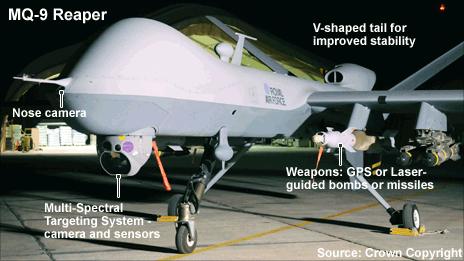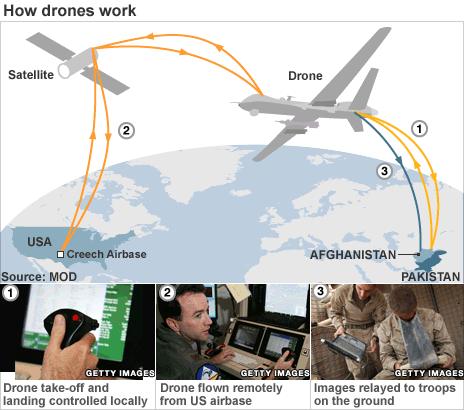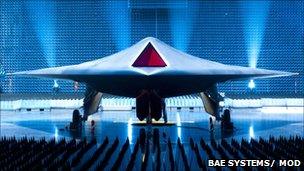Drones: What are they and how do they work?
- Published

President Barack Obama has confirmed the US is using unmanned aircraft to target suspected militants in tribal areas of Pakistan. He defended the drone attacks, saying they made precision strikes and were kept on a "tight leash". What are drones used for and how are they controlled?
To the military, they are UAVs (Unmanned Aerial Vehicles) or RPAS (Remotely Piloted Aerial Systems). However, they are more commonly known as drones.
Drones are used in situations where manned flight is considered too risky or difficult. They provide troops with a 24-hour "eye in the sky", seven days a week. Each aircraft can stay aloft for up to 17 hours at a time, loitering over an area and sending back real-time imagery of activities on the ground.
Those used by the United States Air Force and Royal Air Force range from small intelligence, surveillance and reconnaissance craft, some light enough to be launched by hand, to medium-sized armed drones and large spy planes.
Although the US does not routinely speak publicly about operations involving drones, President Obama has confirmed that they regularly strike suspected militants in Pakistan's tribal areas.
The use of such unmanned aircraft in the area began under President George W Bush, but their use has more than doubled under the Obama administration.
Drones are seen by many in the military as delivering precision strikes without the need for more intrusive military action. However, they are not without controversy.
Hundreds of people have been killed by the strikes in Pakistan - civilians as well as militants, causing outrage. One of the deadliest attacks was in March 2011 when 40 were killed, many believed to be civilians at a tribal meeting.
Key drone types
Two of the medium-sized drones currently in use in Afghanistan and Pakistan are the MQ-1B Predator, external and the MQ-9 Reaper, external.
These strange-looking planes carry a wealth of sensors in their bulbous noses: colour and black-and-white TV cameras, image intensifiers, radar, infra-red imaging for low-light conditions and lasers for targeting. They can also be armed with laser-guided missiles.
Each multi-million dollar Predator or Reaper system comprises four aircraft, a ground control station and a satellite link.
Although drones are unmanned, they are not unpiloted - trained crew at base steer the craft, analyse the images which the cameras send back and act on what they see.

The base may be local to the combat zone or thousands of miles away - many of the drone missions in Afghanistan are controlled from Creech air force base in Nevada, USA - although take-off and landing are always handled locally.
The MQ-1B Predator (formerly called the RQ-1 Predator) was originally designed as an aircraft for intelligence-gathering, surveillance, identifying targets and reconnaissance.
However, since 2002 it has been equipped with two Hellfire II missiles, meaning it can strike at a range of up to 8km (five miles).
By contrast, the newer MQ-9 Reaper was conceived as a "hunter-killer" system.
It can carry four Hellfire missiles and laser-guided bombs such as Paveway II and GBU-12.
Its cruise speed is 370kph (230mph), much faster than the 217kph (135mph) of the Predator which is more vulnerable to being shot down at low altitudes - although the drones would usually be flown above the range of most of the weapons available to the Taliban.
Future craft
The US Army revealed in December that it was also developing new helicopter-style drones with 1.8 gigapixel colour cameras, which promised "an unprecedented capability to track and monitor activity on the ground".

Britain's prototype Taranis is designed to fend off attack
Three of the A160 Hummingbird sensor-equipped drones are due to go into service in Afghanistan in either May or June this year.
The drones will take advantage of the Autonomous Real-time Ground Ubiquitous Surveillance-Imaging System first or Argus-IS, external, which can provide real-time video streams at the rate of 10 frames a second. The army said that was enough to track people and vehicles from altitudes above 20,000 feet (6.1km) across almost 65 square miles (168 sq km).
The US Defense Advanced Research Projects Agency, external (DARPA) is also working with the UK-based defence contractor BAE Systems, external to develop a more advanced version of the Argus-IS sensor that will offer night vision.
It said the infrared imaging sensors would be sensitive enough to follow "dismounted personnel at night".
British capability
British forces also use a variety of remotely piloted aircraft, external. The British Army has used the Hermes 450 UAV in Iraq and Afghanistan, as well as smaller UAVs to help check for roadside bombs ahead of patrols.
The Hermes 450 is being upgraded to the Watchkeeper which, like the Reaper, can be armed. It is due to enter service in 2012.
The RAF also uses the higher-spec Reaper aircraft. In May last year, the RAF announced a new squadron of the drones would be controlled for the first time from a UK base. The Reaper had previously been controlled by RAF crews in the US.
In July 2010, the UK Ministry of Defence unveiled Taranis, its prototype unmanned combat air vehicle which is designed to be able to fend off attack as well as perform the intelligence gathering, surveillance and strike roles of other UAVs.